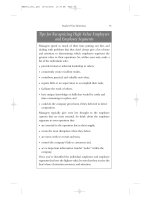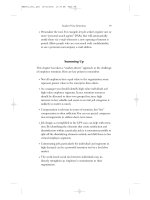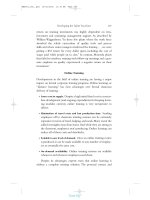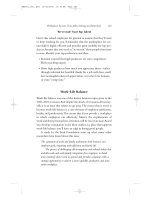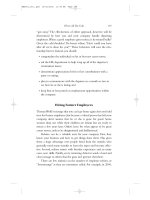Tài liệu Hiring and Keeping the Best People 5 docx
Bạn đang xem bản rút gọn của tài liệu. Xem và tải ngay bản đầy đủ của tài liệu tại đây (102.07 KB, 8 trang )
example:“Why do you think you were selected to lead the task
force?”)
• Accomplishment questions that ask for evidence of the candi-
date’s demonstrated qualities.They help you learn why and
how something was accomplished, and reveal a candidate’s level
of involvement in past accomplishments. (For example:“Tell
me about your contribution to that team effort.”)
• Broad-brush questions that make the candidate think about a
big topic, choose an answer, and organize his or her thoughts.
(For example:“Tell me about your experience as a project
manager with the fiber optics group.”)
• Comparison questions that reveal a candidate’s analytical and
reasoning abilities. (For example:“How would you compare
working with the fiber optics group to working with the poly-
mer group?”)
Bad questions include:
• Leading questions that direct the candidate to the answer you
want. (For example:“Would you say you have the motivation
required for this job?”Would you expect anyone to say “no” to
this?)
• Irrelevant questions that waste everyone’s time. (For example,“I
see that you are a University of Minnesota alumnus. My daugh-
ter may apply there.What are its best programs?”)
Appendix B at the end of this book includes suggested interview
questions organized around key issues such as the candidate’s most
recent job, work experience, and skills.
Questions to Avoid
United States laws and regulations are clear about which questions
are illegal. If you are not familiar with these laws and regulations,
The Hiring Process 19
HBE001_ch1_.qxd 10/03/2002 2:47 PM Page 19
20 Hiring and Keeping the Best People
• Control the situation. It’s your show.
• Don’t buy first impressions. Most people make up their
minds about an applicant within the first ten minutes.This
can be a big mistake.You may miss the real person.
• Help interviewees feel at ease.They’ll open up and talk more
freely.
• Spend more time listening than talking. Interviewers mistak-
enly talk about half of the time. Get the candidate to do 80
percent of the talking.The person asking questions and
listening is the person who’s in control of the interview.
• Have a purpose for every question, otherwise you’re wasting
valuable time with the applicant—and if that person is a hot
commodity, he’ll think less of you and your organization.
• Take notes. Put candidates at ease by telling them you will be
taking notes before you begin writing.
• Don’t make assumptions. Look for repeat patterns of behav-
ior to draw conclusions about the candidate.
• Don’t telegraph the right response to the applicant.Author
William Swan advises against statements like this one:“[I]t’s
critical that anyone in this position be able to work on a
small project team Tell me about your experience and
interest in working in such a setting.”
a
Ask this question and
your applicant will know exactly what you want to hear.
• Be systematic. If you’re interviewing several candidates, be
sure to query each on the same general set of issues: for
example, their backgrounds, what they would bring to the
position, their long-term career objectives, and so forth.Their
responses to this common set of queries will put you in a
better position to compare the candidates.
Tips for Conducting the Interview
a
William S.Swan,Swan’s How to Pick the Right People Program (New York:John Wiley & Sons,Inc.,1989), 18.
HBE001_ch1_.qxd 10/03/2002 2:47 PM Page 20
consult your human resources specialist or legal counsel. Prohibited
questions in the United State include the following:
How old are you?
Are you married?
What is your citizenship?
What is your sexual orientation?
How much do you weigh?
Are you disabled?
When did you graduate from high school?
Do you have children?
What country are you from?
Where were you born?
Have you ever been arrested?
Would your religion prevent you from working on weekends?
For a more complete discussion of legal and illegal interview
questions, see Appendix C,“Legal Landmines in Hiring,” at the end
of this book.
Evaluating the Candidates
Once you’ve interviewed all the candidates, you and others involved
in the hiring decision must conduct an objective evaluation of each
one. A decision-making matrix such as the one shown in figure
1-2 can be a helpful tool for comparing the candidates to one
another. (For an interactive version of this tool, please visit www.
elearning.hbsp.org/businesstools.) Complete this form after you inter-
view each job candidate for a particular position, entering a score for
each of the key areas. By tallying the total scores and reviewing your
notes from the interviews, you will reduce the chance of making a
nonobjective evaluation.
The Hiring Process 21
HBE001_ch1_.qxd 10/03/2002 2:47 PM Page 21
FIGURE 1-2
Decision-Making Matrix
Job Title:
Candidate Name
Key Area Ratings
(poor) 1 to 5 (excellent)
Note:
Note:
Note:
Note:
Note:
Note:
Note:
Note:
Note:
Education
Previous
Appraisal
or Rating
Previous
Experience
Job
Accomplish-
ments
Skills and
Knowledge
Personal
Attributes
TOTAL
Source: HMM Hiring.
HBE001_ch1_.qxd 10/03/2002 2:47 PM Page 22
Common Evaluation Mistakes
Even though you may take a structured, methodical approach to
evaluating your candidates, the evaluation process is still, in the end,
subjective.You can neutralize some of that subjectivity by avoiding:
• being overly impressed with maturity or experience, or overly
unimpressed by youth and immaturity;
• mistaking a quiet, reserved, or calm demeanor for lack of
motivation;
• mistaking the person’s ability to play “the interview game,” or
his or her ability to talk easily, for intelligence or competence;
• allowing personal biases to influence your assessment (for
example, you might be tempted to judge someone harshly
because she reminds you of someone you dislike);
• looking for a friend or for a reflection of yourself in the
candidate;
• assuming that graduates of certain institutions or employees of
certain organizations are automatically better qualified;
• giving too much weight to familiarity with the jargon of your
business;
• focusing only on one or two key strengths and overlooking the
absence of others; and
• failing to value motivation to get ahead.
References Checks
Reference checks verify claims made by the candidate during the
interview process and fill in information gaps.They can also provide
valuable outside perspectives on the candidate and his or her potential
fit with the position. Check references when you are near the end
of your recruiting process and close to making a decision. But be
sure to obtain permission from the candidates first to avoid affecting
The Hiring Process 23
HBE001_ch1_.qxd 10/03/2002 2:47 PM Page 23
someone’s current employment—for example, the applicant’s com-
pany may have no idea that he or she is interviewing for a job else-
where.
In checking references you have two aims.The first is to verify
what the applicant has told you about his or her work experience:
where, how long, last position held, and particular assignments.The
second aim is learn about the applicant’s successes and failures, work
habits, strengths and weaknesses, and so forth.
The business of reference checking is critically important since it
helps assure the hiring company that the job candidate has truthfully
represented his position,work experience,and accomplishments.The
comments of a reference can also provide another slant on the candi-
date’s persona. Unfortunately, particularly in the United States, many
companies are wary of saying much of anything about a current or
former employee for fear of being sued for libel or slander if the
employee fails to get a job because of something they said.So getting
straightforward comments from some references may be difficult.
Here are some tips for checking references:
• Use the telephone to check references. Since nothing is written
down, a person who might be wary of being sued for saying
something negative about the applicant is more likely to give
you a candid response. Don’t check references via letter; you
probably won’t get much information.
• Take a little time to build rapport with the reference; that will
make him or her more comfortable with sharing information
with you.
• Briefly describe the job that the candidate is applying for and
ask if this is something for which the person would be well
suited.
• Ask about the candidate’s style, character, strengths, and
weaknesses.
• Avoid asking vague questions, such as:“Did Jack do a good
job managing his department?” Instead, ask more specific ques-
tions, such as:“What was Jack best at?”;“What did his subordi-
24 Hiring and Keeping the Best People
HBE001_ch1_.qxd 10/03/2002 2:47 PM Page 24
nates like best about him?”;“What did they like least?”;“Are
there any jobs that would be inappropriate for Jack?”;“What
kind of organizational environment would suit Jack best?”
• Let one reference lead to another. If a reference gives you some
information, ask,“Do you know anyone who could tell me
about Jack’s experience in this area?”The more people you talk
to, the clearer a picture you will get.
Many people find reference checking a distasteful chore and
give the task limited attention. Checking references for candidates
“is about as appetizing as eating fish eyes,” says Pierre Mornell.
2
But
the stakes are so high that you must make the effort and be persistent
in digging out the information—even though people may be
unwilling to share it. In his book, Hiring Smart!, Mornell offers this
fast and legal hint for reference checking:
Call references at what you assume will be their lunchtime—you want
to reach an assistant or voice mail. If it’s voice mail, leave this simple
message. If it’s an assistant, be sure that he or she understands the last
sentence of your message.You say “John (or Jane) Jones is a candidate
for (the position) in our company.Your name has been given as a refer-
ence. Please call me back if the candidate was outstanding.”
3
The results, says Mornell, are both immediate and revealing.“If the
candidate is outstanding or excellent, I guarantee that eight out of
ten people will respond quickly and want to help.” In contrast, if
very few or no references return your call, their silence speaks vol-
umes about the candidate without making any derogatory or
libelous statements.
Making the Decision and Offer
Résumés, interviews, and reference checks all inform the decision-
making process.At some point, you must ask yourself,“Do we have
enough information to make a good decision?” If the answer is
“yes,” then it’s time to move ahead with making the hiring decision.
The Hiring Process 25
HBE001_ch1_.qxd 10/03/2002 2:47 PM Page 25
26 Hiring and Keeping the Best People
Rank your top three candidates, and then ask this question of each:
“Do we want this person to work for us?” Remember that the goal
of the hiring process is not to simply choose the “most qualified” of
the existing applicants, but to hire a person who can help the organ-
ization meet its objectives (see “Avoid These Two Hiring Mistakes”).
Once you’ve answered both questions affirmatively, make an
offer to the candidate who is most able and most likely to help your
company meet its goals. If you do not have sufficient information to
make a good decision, then determine exactly what additional
information you and your colleagues need, how you will obtain it,
and what uncertainties you can reasonably expect to reduce. To
reduce important uncertainties you may need to call a candidate
back for yet another interview, or you may need to do more refer-
ence checking.
The Job Offer
Be sure that you understand your organization’s policy on who
makes the job offer. In some organizations,the immediate supervisor
or manager makes the offer. In others, it’s the job of the human
resource department.
Job offers are usually made in person or by telephone. After
extending a verbal offer, you should also send a written confirma-
tion. In both cases, make the offer with enthusiasm and a personal
touch, perhaps by referring to something positive that you recall
from the interview. Even as you make the offer, continue to gather
information from the candidate regarding his or her concerns, the
timing of the decision, and other organizations he or she may be
considering.
The Offer Letter
An offer letter is an official document, so be sure to seek advice from
the appropriate channels before sending it. Do not imply that
the offer is an employment contract. Include important facts in the
letter, such as:
HBE001_ch1_.qxd 10/03/2002 2:47 PM Page 26


